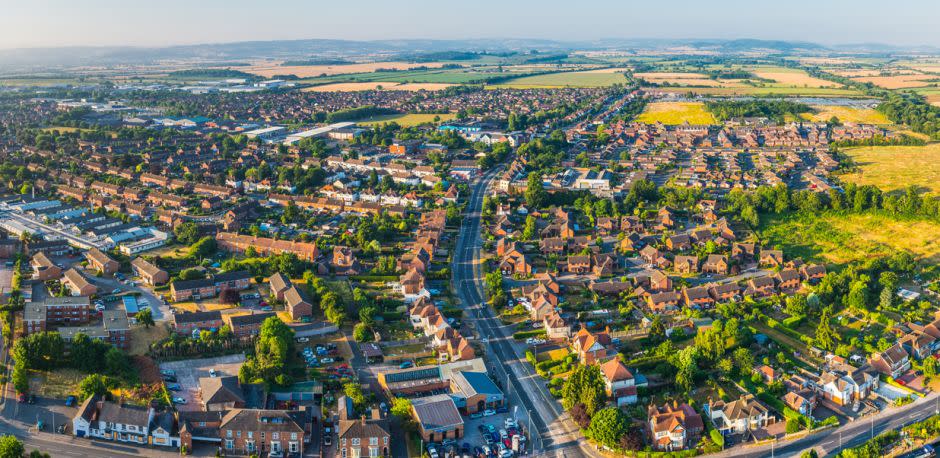Interest rates are a key metric to watch and have driven recent underperformance
The real estate sector is closely tied to the health of the economy, expect ups and downs
Longer term, residential real estate could benefit from the supply and demand imbalance
What is the real estate sector?
The real estate sector covers lots of businesses involved in developing, maintaining, selling, or letting land or property.
The residential subsector focuses on buying and selling properties for housing. The commercial subsector consists of real estate used for business like offices, retail and hotels. The industrial subsector includes properties used for manufacturing and production, like factories and warehouses.
The real estate sector is cyclical. That means demand and performance tend to ebb and flow along with the health of the broader economy.
How has the real estate sector performed?
Over five years, the UK real estate sector, excluding housebuilders, has underperformed the broader market by around 40%*. But for most of that time, it actually tracked the wider market more closely.
The big differences started at the tail end of 2021, when the real estate sector peaked and then began to fall significantly. The underperformance since then has been mostly due to rising interest rates, which began increasing around the same time. UK housebuilders’ performance has been much more extreme over the same time period, because of its cyclical nature.
Get key share takeaways from the week direct to your inbox every Friday.
How do interest rates affect real estate?
Real estate purchases are often made using large amounts of debt (think of a mortgage to buy a house). That means the sector is extremely sensitive to changes in interest rates – as they go up, it makes borrowing more expensive.
From a lender’s point of view, they want to be compensated fairly for the risks involved with lending funds. They typically want to get a return that’s at least as good as what they can expect from keeping money in the bank – the base interest rate.
While there are lots of other factors, generally, when interest rates go up, mortgage rates tend to go up too – which is exactly what we’ve seen since the tail end of 2021.
And because higher interest rates make it more costly, all else being equal, people are less inclined to take out a mortgage, so demand falls.
Higher rates also increase the costs associated with developing new or renovating pre-existing properties, which worsens the current supply and demand imbalance and drives up rent.
On the flip side, when interest rates are low or falling, the effects are typically reversed and there’s likely to be a few tailwinds pushing the sector forward. That’s shown by the sector line tracking closer with the wider market until interest rates started to climb at the end of 2021.
What about housebuilders?
As the name suggests, UK housebuilders are very much focused on residential real estate.
Generally, their balance sheets are on fairly solid ground. Healthy net cash balances have been boosted by the sector reining in land spend and managing in-progress projects carefully.
But we’re still concerned about an impending recession, sky-high inflation, and rising interest rates – all of which can negatively affect affordability.
Stubbornly high inflation is already stretching potential buyers’ disposable incomes. And with UK interest rates rising to 5% and possibly more rate rises on the way, mortgage rates are likely to tick upwards too. That will only add to the affordability issue, especially for first-time buyers trying to get on the ladder.
The key question for housebuilders is just how much further affordability will get squeezed, and what impact this will have on prices and housing demand.
In the first half of 2023, house pricing remained resilient. But recent data from Halifax has shown the first annual decline in average UK house prices since 2012, with the typical UK property now costing around £286,500.
On top of that, mortgage rates have eclipsed 6% for the first time since December 2022, contributing to a lack of urgency for buyers to sign on the dotted line.
We don’t know yet whether these are temporary blips or the start of trends, so we’ll be keeping a close eye on developments. If it’s the latter, expect further downward pressure on housebuilders’ top lines moving forward.
Something that caught our eye was the increasing use of incentives, particularly aimed at first-time buyers. Offering incentives helps to boost sales rates but inevitably has a negative effect on margins.
And build-cost inflation has been eating into margins too, hovering around double-digits over the last year. There are hopes of this easing as weak comparative periods work their way through, but we’ll have to wait for more concrete signs.
Given all the headwinds, analysts are expecting a sharp fall in profits this year as volumes fall by around 25% on average. If this happens, it’s possible that some housebuilders’ dividends could be lowered in an effort to conserve cash for rainy days.
Price-to-book (PB) ratio is a way to value a company by its book value, or the value of its assets minus liabilities. Book value tells you how much a company would be worth if it were liquidated today – at least in theory.
Most think a PB ratio over much more than one can signal a company is overvalued – it suggests investors are paying more than the underlying business is worth.
Key figures shouldn’t be looked at on their own – it’s important to understand the big picture.
On a price-to-book basis, housebuilders’ valuations are some way lower than their long-term averages, so a lot of this pain looks built in already.
The risks of further downward pressure on valuations increases the longer that interest rates stay high. Especially if higher rates lead to a recession with unemployment rising significantly.
We’d encourage investors to focus on the long-term outlook, and current valuations suggest there could be opportunities if near-term challenges can be navigated well. Although, there are no guarantees.
Other corners of the sector
Landlords buying commercial property now are going to demand higher rental yields to make the risk of buying say, an office block, worth it compared to putting money in the bank.
That means that either rents have to rise, or the sale price of the office block needs to fall, or even a mixture of the two. So, when interest rates rise, property values immediately take a hit.
On top of that, the pandemic displaced a lot of economic activity. Hybrid working appears to be the ‘new normal’ for a lot of businesses, meaning that commercial property demand in a lot of areas has dropped – worsening the fall in some valuations.
If the economy slides, some businesses are also likely to go bust and stop paying their rents, adding to the woes of commercial landlords.
The shift to e-commerce and the nearshoring of supply chains has increased the demand for warehouses, pushing these rents higher. Despite this, the subsector’s strong structural growth drivers could offer more resilience than offices and retail units in difficult times.
We think large-scale businesses are less likely to struggle forking out for higher rents than their smaller counterparts.
Real Estate Investment Trusts (REITs) can give investors exposure to property portfolios across various subsectors for as little as the price of a single share.
A REIT is a company that owns, operates or finances income-generating real estate. REITs pool together capital from lots of investors to fund property purchases, providing investors with a relatively cheap way to invest in the real estate sector.
Most REITs are publicly traded like stocks which makes them easy to buy and sell, unlike physical real estate. They also tend to generate a steady income stream for investors because they have to pay out most of their profits as dividends. If rent collections or occupancy fall though, that can directly dent the level of shareholder payouts.
Our view
There’s plenty of short-term uncertainty in the sector. What happens next with interest rates is going to be key. If inflation turns out to be stickier than expected, then rates will likely rise further, ultimately causing more pain for the sector.
While it’s a cyclical sector, it’s hard to ignore that there’s a fundamental undersupply of homes. This isn’t likely to change in the short-to-medium term, and for now, it’s helping to prop up house prices.
Most housebuilders look well-prepared for turbulence in the short term, with strong balance sheets and healthy net cash balances on hand. But if rates stay higher for longer, valuations come under further pressure. Longer term, we’re cautiously optimistic about the outlook for real estate – housebuilders in particular.
Brits are ideologically committed to home ownership and the current supply and demand imbalance provides a strong platform for growth if near-term challenges can be overcome. But remember, there are no guarantees.
As always, remember investments and any income from them can fall as well as rise in value so you could get back less than you invest. This isn’t personal advice – if you’re not sure what’s right for you, ask for advice.
Our last review looked at how the industrials sector has performed, what’s next for 2023, and the biggest opportunities for the sector.
This article is not advice or a recommendation to buy, sell or hold any investment.No view is given on the present or future value or price of any investment, and investors should form their own view on any proposed investment.This article has not been prepared in accordance with legal requirements designed to promote the independence of investment research and is considered a marketing communication.Non - independent research is not subject to FCA rules prohibiting dealing ahead of research, however HL has put controls in place(including dealing restrictions, physical and information barriers) to manage potential conflicts of interest presented by such dealing.Please see our full non - independent research disclosure for more information.



